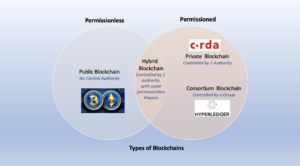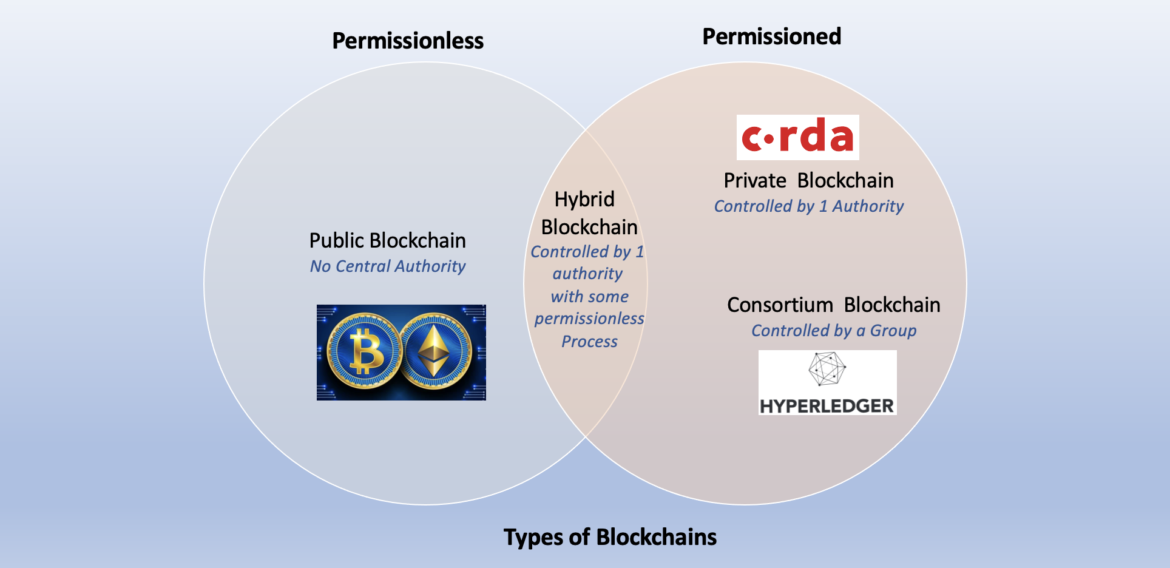Unlocking the Secrets of Blockchain: Discover its Different Types !
Here in this blog, we will be Unlocking the differences between the various Blockchain. It will also uncover various implementation types, frameworks available, and use cases. The Blockchain Platforms that help to do the seamless implementation of various use cases are also covered in this post.
There are primarily 2 types of blockchain networks:
Permissionless and Permissioned Blockchain
A permissionless blockchain network, also known as a public blockchain. It is an open network that allows anyone to participate, transact, and validate transactions without needing permission from a central authority.
Examples of permissionless blockchains include Bitcoin and Ethereum.
Here, users can join the network and transact anonymously, without having to reveal their identity or obtain permission from a central authority. This makes permissionless blockchains more decentralized and democratic, but it also makes them more susceptible to security threats and scalability issues.
On the other hand, a permissioned blockchain network, also known as a private blockchain, is a closed network that requires permission from a central authority to join, transact, and validate transactions.
Examples of permissioned blockchains include Hyperledger Fabric and Corda.
In a permissioned blockchain, access and participation are restricted to a specific group of users who have been granted permission by the central authority. This makes permissioned blockchains more secure and efficient, but it also makes them less decentralized and less democratic.

- Public blockchain: This type of blockchain network is open to everyone and anyone can participate in the network. Public blockchains are decentralized and operate on a consensus mechanism, meaning that the majority of the nodes on the network must agree on transactions before they can be validated and added to the blockchain. Examples of public blockchains include Bitcoin, Ethereum, and Litecoin.
- Private blockchain: Private blockchains are restricted to a specific group of users or organizations. These networks are usually used by businesses for internal purposes, such as tracking supply chain management or managing financial transactions. Private blockchains are centralized and the nodes that validate transactions are controlled by a single entity or a group of entities.
- Consortium blockchain: A consortium blockchain is a hybrid between public and private blockchains. These networks are shared between a group of organizations that have a vested interest in the network. Consortium blockchains can be used for specific purposes such as managing supply chains or tracking healthcare records. The nodes on the network are controlled by a group of entities, but the network is still decentralized and operates on a consensus mechanism. Examples of consortium blockchains include R3 Corda and Hyperledger Fabric.
- Hybrid Blockchain: Hybrid blockchain is often referred to as a combination of both public blockchain and private blockchain. It blends essential components of both public blockchain and private blockchain and with the mix of the best of both public and private blockchain protocols, it makes transactions and data private.
Implementation Types
Each type of blockchain network (public, private, and consortium) can have different variations and implementations. Here are some examples of different types of blockchains within each category:
Public blockchain:
- Proof of Work (PoW) blockchain: This is the most common type of public blockchain, used by Bitcoin and some other cryptocurrencies. It uses complex mathematical calculations to validate transactions and create new blocks.
- Proof of Stake (PoS) blockchain: This type of blockchain uses a consensus mechanism where validators are chosen based on the amount of cryptocurrency they hold, rather than on their computational power. Examples include Ethereum 2.0 and Cardano.
- Delegated Proof of Stake (DPoS) blockchain: This type of blockchain uses a small number of validators (often referred to as “witnesses” or “delegates”) who are elected by token holders. This is used by EOS and Steem.
Private blockchain:
- Permissioned blockchain: This type of blockchain network requires permission to join, and only authorized participants can participate in the network. It is often used for enterprise applications, such as supply chain management or interbank settlements.
- Hybrid blockchain: A private blockchain that allows some data to be shared with a public blockchain.
Consortium blockchain:
- Federated blockchain: A consortium blockchain where multiple organizations have the power to validate transactions and maintain the network.
- Quorum blockchain: A consortium blockchain created by JP Morgan that uses Ethereum technology but has some modifications to enable privacy and higher throughput for financial transactions.
Available blockchain frameworks
Public blockchain:
- Bitcoin Core: This is the original implementation of the Bitcoin blockchain, which uses the PoW consensus mechanism.
- Ethereum: A popular blockchain platform that allows developers to create decentralized applications (dApps) and smart contracts. It uses the PoW consensus mechanism but has moved towards PoS with the upcoming Ethereum 2.0 upgrade.
Private blockchain:
- Corda: Permissioned blockchain framework that is designed for use in financial services. It allows parties to transact directly with each other without the need for a central authority.
- Quorum: Permissioned blockchain framework created by JP Morgan that is based on Ethereum technology but has additional features to support privacy and high throughput.
Consortium blockchain:
- Hyperledger Fabric: A blockchain framework that is used for enterprise applications. It allows organizations to control who can participate in the network and has more privacy features than public blockchains.
- Hyperledger Sawtooth: A blockchain framework that is designed for building scalable and secure enterprise blockchain applications. It supports both permissioned and permissionless use cases.
- Hyperledger Indy: A blockchain framework that is designed for digital identity management. It allows users to control their own identities and share only the information they want with others.
- R3 Corda: A permissioned blockchain framework that is used for financial services applications. It allows parties to transact directly with each other while maintaining privacy and security.
Companies adopted blockchain
Public blockchain:
- Bitcoin: The original and most well-known cryptocurrency that uses the Bitcoin Core implementation of the blockchain.
- Ethereum: A popular blockchain platform that allows developers to create decentralized applications (dApps) and smart contracts.
- Ripple: A cryptocurrency that uses a consensus mechanism called the Ripple Protocol Consensus Algorithm (RPCA) and is designed for fast, low-cost global payments.
Private blockchain
- IBM: The technology company has developed the Hyperledger Fabric framework, which is used for enterprise applications.
- Microsoft: The software giant has developed the Azure Blockchain Workbench, which is a tool for building and deploying blockchain applications on the Microsoft Azure cloud platform.
- JPMorgan Chase: The financial services company has developed the Quorum blockchain framework, which is used for financial services applications.
Consortium blockchain:
- R3: A blockchain consortium that has developed the Corda blockchain framework, which is used for financial services applications.
- B3i: A consortium of insurance companies that are using blockchain technology to streamline the insurance industry.
- We.Trade: A consortium of European banks that is using blockchain technology to create a platform for cross-border trade finance.
blockchain as a PAAS
Public blockchain:
- Infura: A service that provides Ethereum nodes to developers, allowing them to build decentralized applications without needing to run their own node.
- BlockCypher: A service that provides APIs for Bitcoin and other cryptocurrencies, allowing developers to build applications that interact with the blockchain.
- Alchemy: A blockchain developer platform that provides infrastructure and tools for building scalable blockchain applications.
Private blockchain:
- IBM Blockchain Platform: A cloud-based blockchain platform that provides tools for developing, deploying, and managing blockchain networks.
- Amazon Managed Blockchain: A managed blockchain service that allows customers to create and manage their own blockchain network.
CONSORTIUM blockchain:
- Oracle Blockchain Platform: A platform that allows customers to build and deploy blockchain applications using Hyperledger Fabric.
- Corda Enterprise: A version of the Corda blockchain framework that is designed for enterprise use cases and provides additional features and support.
- Chainstack: A platform that allows users to deploy and manage blockchain networks, including Corda and other consortium blockchains.
- Kaleido: A blockchain-as-a-service platform that provides tools for building and deploying blockchain networks, including both public and private blockchains.
Blockchain use-cases
Public blockchain:
- Cryptocurrencies: Public blockchains like Bitcoin and Ethereum are primarily used as a medium of exchange and store of value, allowing users to send and receive payments without the need for intermediaries.
- Decentralized applications (dApps): Ethereum and other public blockchains can be used to build and deploy dApps, which are decentralized applications that run on the blockchain and have no single point of control.
- Digital identity: Public blockchains can be used to create decentralized digital identity systems that allow users to control their own identity data and authenticate themselves in a trustless manner.
Private blockchain
- Supply chain management: Create secure, transparent supply chain networks that allow participants to track goods and materials throughout the supply chain.
- Financial services: It can be used by banks and other financial institutions to streamline payment processing, reduce fraud, and improve transparency.
- Government services: Private blockchains can be used by government agencies to manage identity, voting, land registration, and other public services in a secure and transparent manner.
Consortium blockchain:
- Inter-organizational processes: Streamline business processes between multiple organizations, such as supply chain management, procurement, and trade finance.
- Healthcare: Securely share and manage patient data between healthcare providers, while ensuring patient privacy and data security.
- Energy and utilities: Manage energy and utility networks, like tracking energy usage and billing between multiple parties.
That’s all about the secrets of Blockchain.
Hope you enjoyed reading this article
Further Readings
Blockchain Technology: The Future of Secure and Transparent Transactions
Subscribe to our YouTube channel to get regular updates.



